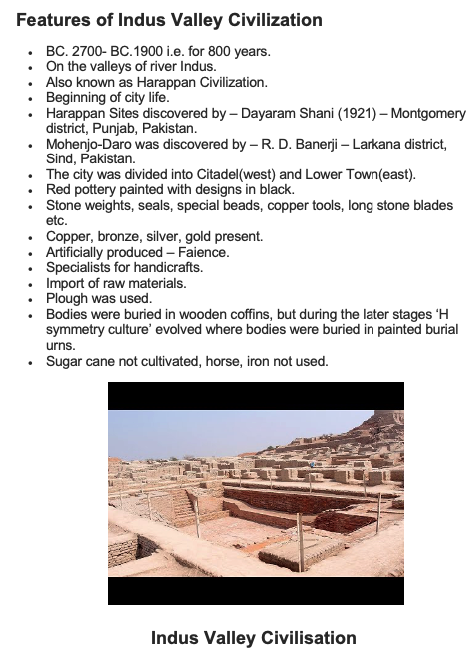Life in the Indus Valley
Summary:
The Indus Valley Civilization, also known as the Harappan Civilization, flourished for approximately 800 years, from 2700 BC to 1900 BC, in the valleys of the Indus River. The civilization marked the beginning of city life and exhibited various distinctive features. Archaeologists like Dayaram Sahni and R. D. Banerji discovered Harappan sites. The cities were divided into citadels and lower towns, with unique red pottery painted with black designs. Artifacts include stone weights, seals, copper tools, and special beads, reflecting their advanced craftsmanship. The civilization had access to metals like copper, bronze, silver, and gold and produced the artificial material called faience. Notable sites like Mohenjodaro, Harappa, Chanhu-daro, Kalibangan, Lothal, Ropar, Banawali, and Dholavira showcased advanced urban planning and trade networks. The civilization had a unique religious belief system, featuring Pashupati Mahadev (Proto Siva), mother goddess, and nature/animal worship. Despite the decline of the civilization, the exact reasons remain uncertain, with theories attributing it to weaker monsoons, environmental changes, resource shortages, interpersonal violence, and potential migration towards south India. The Aryan invasion theory and tectonic movements/floods have also been proposed as potential causes.
Excerpt:
Life in the Indus Valley
Features of the Indus Valley Civilization
- 2700- BC.1900, i.e. for 800 years.
- On the valleys of river Indus.
- Also known as Harappan Civilization.
- Beginning of city life.
- Harappan Sites discovered by – Dayaram Sahni (1921) – Montgomery district, Punjab, Pakistan.
- Mohanjodaro was discovered by – R. D. Banerji – Larkana district, Sind, Pakistan.
- The city was divided into Citadel(west) and Lower Town(east).
- Red pottery painted with designs in black.
- Stone weights, seals, special beads, copper tools, long stone blades etc.
- Copper, bronze, silver, and gold are present.
- Artificially produced – Faience.
- Specialists for handicrafts.
- Import of raw materials.
- Plough was used.
- Bodies were buried in wooden coffins, but during the later stages, ‘H symmetry culture’ evolved, where bodies were buried in painted burial urns.
- Sugar cane was not cultivated, and horses and iron were not used.


Reviews